White Papers
Understanding Carbon Black Reinforcement in Rubber
November 4, 2016
Carbon black reinforcement and the relationship between carbon black grades and rubber durability have intrigued researchers for nearly a century, yet the reinforcing mechanism remains partially understood. In this article, we explore how variations in carbon black particle size, aggregate structure, and surface area contribute to rubber reinforcement. While the differences in rubber’s structure pre- and post-carbon black addition are evident, the specific structural disorder introduced by compounding various carbon black types is not fully elucidated. These structural changes correlate with the final rubber product’s durability and its adhesive bond with substrates.
Our research delves into the cohesion and adhesion forces in peroxide-cured 1, 4-cis polyisoprene when different grades of carbon black compounded into the rubber formulation. Lap shear measurements between the vulcanized rubber and the metal substrate have been correlated with the microstructural changes associated with the rubber in the curing process, detected by spectroscopy. These results could have a significant bearing on the mechanism of carbon black reinforcement as well as the strength development in adhesion forces of rubber-metal bonding to produce a uniform, high-quality product that is free from failure. The results are discussed in the light of polymer conformation and carbon black aggregate structures.
A considerable amount of interest exists in characterizing the nature of carbon black binding to the polymer and associated properties. Even though the existence of different degree of reinforcement with different types of carbon black have been previously established for natural rubber, experimental evidence suitable for microstructural analysis is rare. Most of the studies, including the modulus or tensile strength measurements, thermal measurements, or optical microscopy are not actually directed at obtaining the details of the microstructures.
The FT-IR external reflection experiment by Kardan and co-workers 1-5 has revealed that when a polymer is coated on a substrate, each structural subunit of the polymer has a defined orientation on the external surface. The orientation of the polymer on the surface and its adhesion to the substrate depends on its conformational changes, which are influenced greatly by the interaction of the polymer with the media 6-10. In this study, we have used ATR FT-IR spectroscopy as a primary technique to analyze the polymer structural changes in the carbon black-rubber composites when coated on a metallic substrates. The correlation of the infrared results with the measured lap shears for the cured composites, when molded on metallic substrates can be useful in the elucidation of the carbon black reinforcement mechanism. Because of the similarity in structure between natural rubber and many other elastomers, the structural information we deduce from this analysis can be transferred to other elastomer- carbon black adhesive and sealant systems.
Composites of synthetic natural rubber, cis-1, 4 polyisoprene (Nipol IR2200), provided by Zeon Chemicals with carbon-black of different grades were made by mill compounding the carbon black, peroxide, and processing aids ( Vernay Proprietary formulation) into the rubber under the exact same conditions. Eight different grades of carbon blacks with particle sizes ranging from 20 to 240 nm were used in this study. For all prepared composites, the carbon black level was kept at 20 phr (20 part carbon per hundred part of rubber).
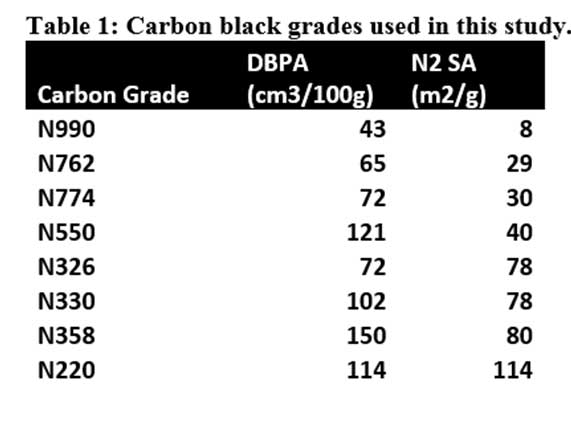
A 20 inches wide two roll mill, each with 10 inches diameter from Kobelco Stewart Bolling, Hudson, OH, USA were used to mill band the polymer and then the other ingredients were incorporated in the polymer blend by gradual addition to the mill at room temperature.
The cure curves or Rheographs for each composite were obtained by plotting torque (force displacement) values against time for 6 minutes at 180 °C using a MDR (Moving Die Rheometer) Model 2000, provided by Alpha Technologies, Akron, OH, USA. To measure cohesion bond strengths to substrate, samples of each composite were molded 4 minutes at 180°C to a one inch (25.4 mm) wide stainless steel substrate2,, using a special compression mold where the interface between the molded composite and the substrate is one square inch (6.45 cm2) and the thickness of the molded rubber is 0.25 inch (6.35 mm). Prior to molding a topcoat of a primer, developed at Vernay to maximize the anchorage of subsequently applied cured composite to metal, was applied to the steel substrates at 0.025 mm (1 mil) thickness and allowed to dry at room temperature overnight.
An Instron 5565 Tensile Tester (Instron, USA), was used to measure the lap shear force between the vulcanized rubber and the metal substrate. The same tensile tester was used to measure the modulus and elongation in each vulcanized samples. A digital Durometer model DD-3 from Rex Gauge Company was used to measure ShA hardness of each cured sample. ATR FT-IR spectra of all cured compound samples were obtained using Model 610 FTIR microscope (Agilent Technologies, USA). Crosslink density in each cured sample was measured using Time Domain Relaxation NMR instrument model mq20 from Bruker.
One of the main goals of our analysis is the characterization of the structural aspects of natural rubber in the composites with different grades of carbon black. It is generally accepted that the particle size, aggregate structure, and the surface area of the carbon black are important factors in reinforcing the rubber. However, it is not clear what structural differences exist between the rubber before and after the reinforcement. Nor is it clear how structural disorder is introduced when different types of carbon black are compounded into the rubber. These structural changes are associated with carbon black – rubber interaction.Although the loading level for different grades of carbon black is a critical factor in achieving the degree of rubber modification for desired end use application, this level was deliberately kept constant at 20 phr for all carbon black grades in our studies. The level of carbon black was kept constant to ensure that we had a reasonable understanding of polymer-carbon black interactions. The plot of the measured shear vs. extension with the primer on the metal surface, for different carbon blacks in the composite is shown in Figure 1.
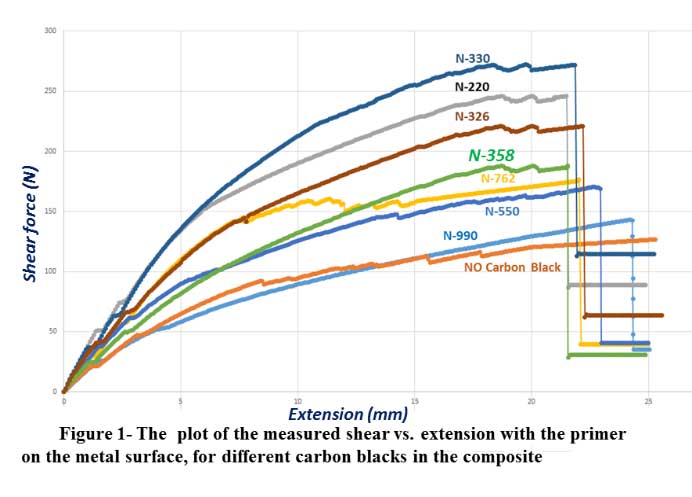
The adhesion bond between the composite and the primer did not fail during the test, nor did the adhesion bond between the primer and the steel substrate. Therefore, we would interpret that the measured lap shear values are directly related to the cohesion forces or durability in the composites.
Nitrogen surface area (specific surface, determined by nitrogen absorption capacity) and DBPA (the Dibuthyl phtalate absorption which is a measure of carbon black aggregate structure), listed for each carbon grade in Table I, are both measure of the carbon black’s surface area. Carbon black is composed of clusters of fused prime particles called primary aggregates. If the primary aggregates composed of many prime particles, with considerable branching and chaining, is referred to as a high structure black. From Figure 1, it can be seen that the lap shear increases with increasing both carbon black nitrogen surface area and DBPA absorption values. It appears that these increases are more pronounced and correlated with increasing DBPA absorption values than they are with increasing nitrogen surface areas.
The measured torque value in MDR cure curves for each composite plotted in Figure 2, which is a direct indication of the sample’s shear modulus (resistance to shearing deformation) also shows such a drastic changes, when different carbon blacks are compounded in the composite. The MH value, which is the indication of the composite modulus for each curve increases with increasing both carbon surface area and cluster structure. Again, these increases are more pronounced and correlated with increasing DBPA absorption values than they are with increasing nitrogen surface areas. Time Domain Relaxation NMR (TD-NMR) was used to determine the cross-link density of each vulcanized composite at room temperature. Figure 3 shows the relaxation time for each composite, the lower the relaxation time indicates the higher the cross-link density in the composite.
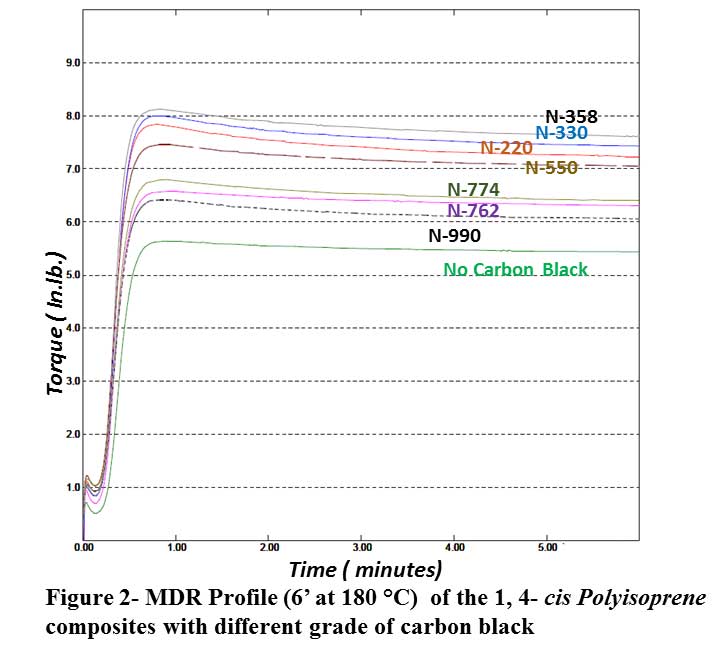
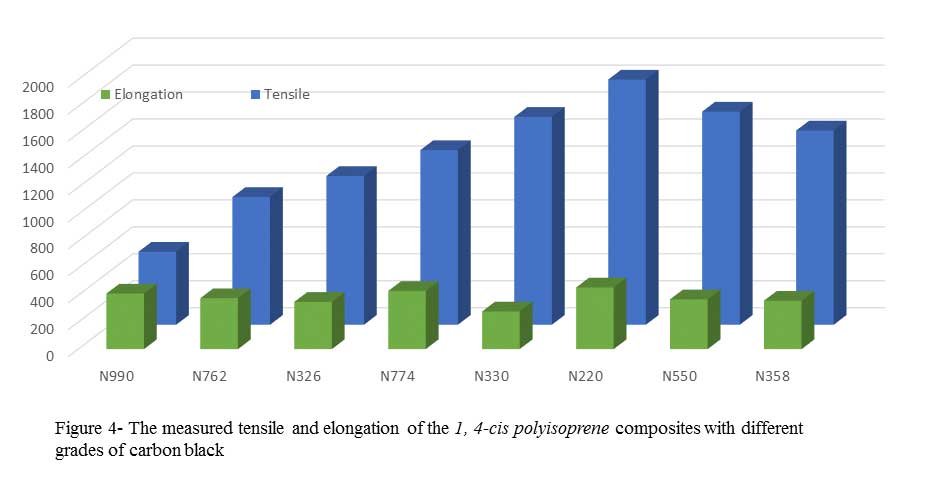
The plots in Figures 1, 2, and 3 all indicate that the properties of both primary aggregates and spherical particles comprising them are important controlling factors in carbon black performance. Higher surface areas, as imparted by finer prime particle blacks, require more energy for wetting and dispersion and they tend “tie up” more rubber per unit weight of carbon resulting in stiffer compounds than with coarser blacks. The measured tensile for the vulcanized composites, shown in Figure 4 are also well correlate with DPBA absorption values of the carbon black used in composite. Here, it is worthwhile to indicate that, in Figures 4, the changes in surface area or the aggregate structure in carbon black has affected tensile, but the elongation remains almost unchanged with change in surface area in carbon black. We will discuss these differences as we analyze the structural changes of the two rubbers using vibrational spectroscopy.
In analyzing the infrared results, our discussions will first center on the structure of the polyisoprene and then the structural changes, as different grades of carbon blacks are milled into the rubber will be discussed. The task is made easier by analyzing well assigned infrared vibrations, which are localized in nature with well-defined transition moments.
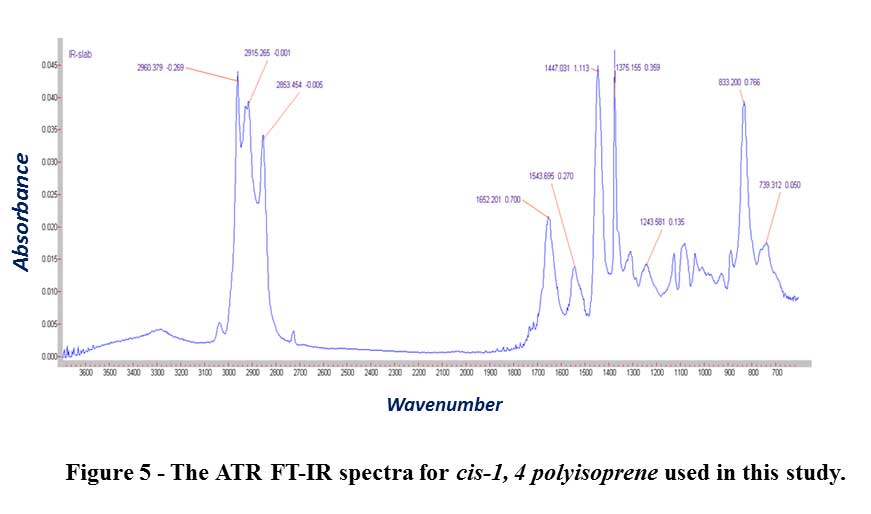
Figure 5 shows the ATR FT-IR spectra for cis-1, 4 polyisoprene used in this study. Although they are not as well understood, the infrared active bands in the high frequency CH stretching region can be extremely rich in structural information. Two bands near the 2960 cm-1 and 2853cm-1 region can be assigned to the CH3 asymmetric and symmetric stretching vibrations, respectively and the bands at 2927 cm-1 and 2914 cm-1 are assigned to methylene (CH2) asymmetric and symmetric stretching vibrations, respectively. The relative intensity of the methyl and methylene stretching vibrations gives valuable information on the orientation of C-C sequences on a metallic surface 1-6.
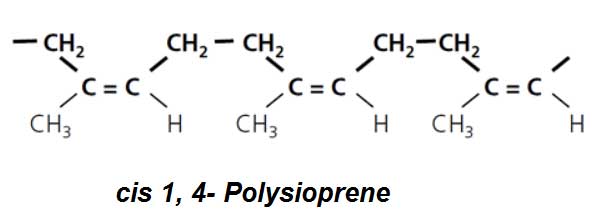
For cis-1, 4 polyisoprene and its composites, the CH stretching, bending, and rocking vibrations are shown in Figures 6 and 7, respectively. In these figures, N-330 and N-990 carbon blacks are shown, as examples because of the large differences which exist between their particle sizes and surface areas. Also, the lap shears results, in Figure 1 and MDR results in Figure2 indicate that the N-330 carbon black is a strongly reinforcing and N-990 is a weakly reinforcing carbon black.
From Figure 6, it is quite evident that for the CH stretching region, substantial intensity differences exist between the polymer with no carbon black, the polymer with N-990 and the polymer with N-330 carbon black. These differences are associated with the interaction between carbon black and polyisoprene.
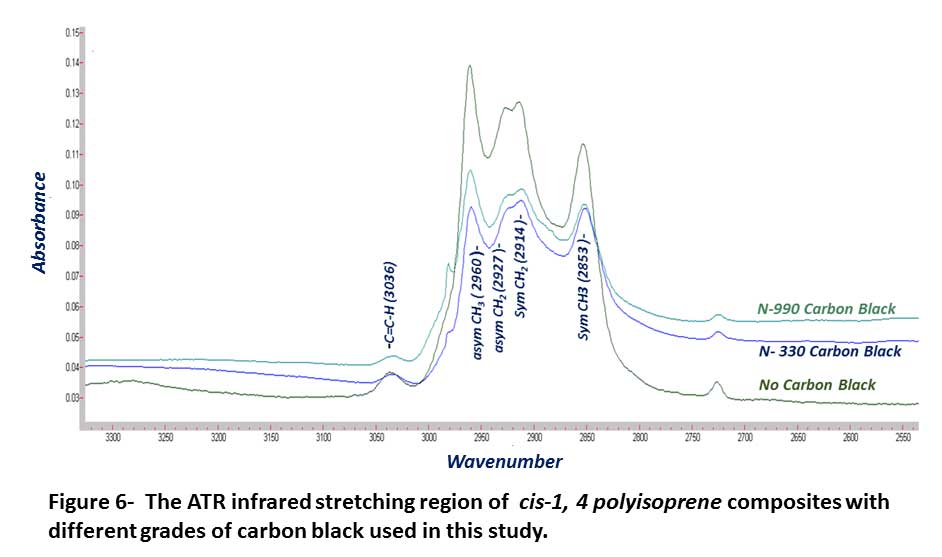
In Figure 7, the intensity of 1447 cm-1 absorption band increases with respect to 1375 cm-1, when cis-1, 4 polyisoprene is filled with N-330 carbon black, whereas this ratio slightly decreases when the synthetic rubber is filled with N-990 carbon black. These two bands have been assigned to bending vibrations of Trans and gauche conformations, respectively, of freely rotatable C-C bonds10, 11. It should be noted here that the infrared data for the other carbon blacks used in this study shows the similar pattern of behavior. The band at 833 cm-1, which has been assigned to cis-1, 4- polyisoprene =CH out -of- plane bending mode17 was used as a reference peak to compare the 1400 region intensities for different composites of the polymer. We have noted that the calculated ratio of 1447cm-1 band to 1375 cm-1 in the spectra will slightly increase with increasing carbon black DBP absorption values. The interaction between carbon black and the polymer, therefore, results in a loss of preferred conformation, conceivably because the polymer forms a strongly absorbed surface layer.
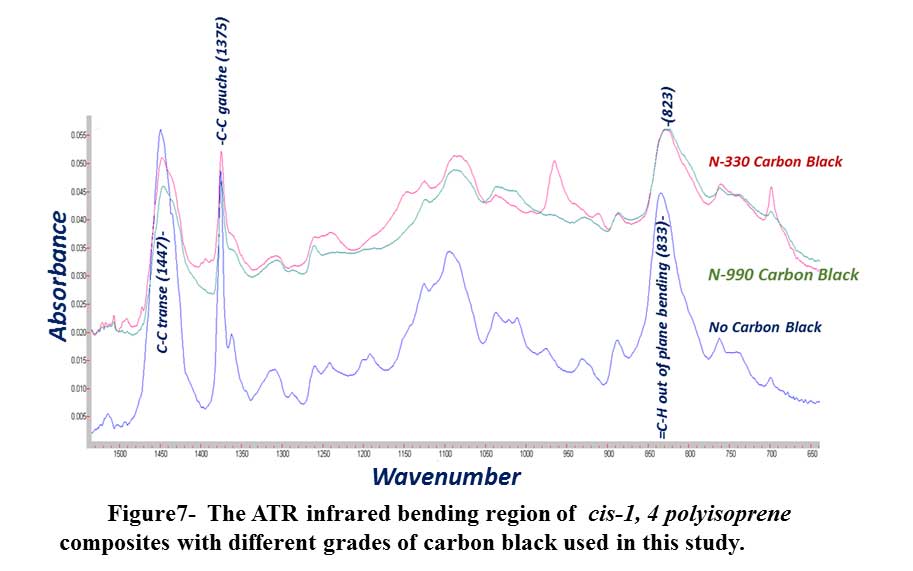
Further, we would interpret that the inactive carbon black Thermax 990 leads to an increased amount of chemical cross-links within the elastomeric polymer network, perhaps due to introduced surface chemistry by the manufacturer, which will cause a significant decrease in the CH2 bending intensity. In contrast, the reinforcing carbon black will not participate in any cross-links within the network. This conclusion is especially consistent with our NMR results as well as with our tensile elongation results and also consistent with the recently reported 1H NMR relaxation results for natural rubber filled with carbon black. The relaxation results in that study indicated that in the process of curing natural rubber, active carbon black resulted in a higher reduction of cross-link densities than inactive carbon black12. Therefore, it is not unlikely that carbon black primary aggregates or high-structure aggregates reinforce the rubber structure by entanglement and mechanical interlocking forces.
The strength related properties such as cohesion forces in rubber compounds are enhanced by higher carbon black surface area. The degree to which carbon particles bound together in aggregates (primary structure) and the agglomeration of aggregates due to Van der Waals forces (secondary structure) play important role in reinforcing the rubber and enhancing the cohesion forces in vulcanized polyisoprene.
The interaction between carbon black and the polymer, therefore, results in a loss of preferred conformation, conceivably because the polymer forms a strongly absorbed surface layer. We have provided some evidence that reinforcing carbon black will not participate in any cross-links within the elastomer network and most likely the carbon black primary or high structure aggregates reinforce the rubber structure by formation of entanglement network or mechanical interlocking forces. The infrared results indicate that the reinforcement mechanism promotes the trans- conformation in the rubber structure.
Vernay Laboratories has been a technology leader in the design, development, and manufacture of customized flow-control components since its founding in 1946. The company also formulates its own compounds to address each specific application.
Vernay’s products play a vital role in millions of medical devices, automobiles, and consumer products. Today, the privately held firm produces more than 1 billion components per year, drawing from a library of more than 33,000 elastomeric materials and compound formulations. It operates six plants around the world, in the U.S., the Netherlands, Italy and China. For more information, visit www.vernay.com.